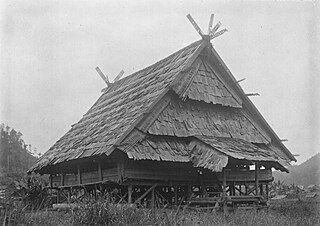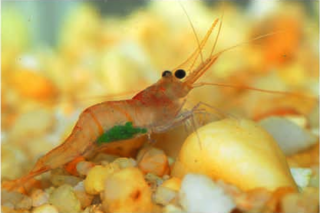
Sulawesi, also known as Celebes, is an island in Indonesia. One of the four Greater Sunda Islands, and the world's eleventh-largest island, it is situated east of Borneo, west of the Maluku Islands, and south of Mindanao and the Sulu Archipelago. Within Indonesia, only Sumatra, Borneo, and Papua are larger in territory, and only Java and Sumatra have larger populations.

Caridina is a genus of freshwater atyid shrimp. They are widely found in tropical or subtropical water in Asia, Oceania and Africa. They are filter-feeders and omnivorous scavengers. They range from 0.9–9.8 mm to 1.2–7.4 mm in carapace length.

Lake Poso is a lake in Central Sulawesi, Indonesia, and the third-deepest lake in Indonesia.

Lake Towuti is a lake in East Luwu Regency, South Sulawesi province, Indonesia. Surrounded by mountains, it is the largest lake of the island of Sulawesi and one of the five lakes of the Malili Lake system. A river flows from the lake to the Boni Bay. The town Laronda is located on its shore.

Lake Matano, also known as Matana, is a tropical lake in East Luwu Regency, South Sulawesi province, Indonesia, that is noteworthy for the unique environment in its deeper layers.

Caridina dennerli is a small species of freshwater shrimp from Sulawesi (Indonesia) that grows up to 2.5 centimetres (1.0 in) in length. It takes its name from the German company Dennerle, which supported the expedition that led to the scientific description of the species. It is popularly known as the 'cardinal shrimp' in the aquarium trade.

Tylomelania is a genus of freshwater snails which have an operculum, aquatic gastropod mollusks in the family Pachychilidae. In the aquarium hobby, snails from this genus are commonly known as "rabbit snails".

Tylomelania sarasinorum is a species of freshwater snail with an operculum, an aquatic gastropod mollusk in the family Pachychilidae.

Tylomelania towutica is a species of freshwater snail with an operculum, an aquatic gastropod mollusk in the family Pachychilidae.
Dennerle is a German company producing aquarium and pond supplies. It was founded in 1966 as a pet store by Ludwig Dennerle in Pirmasens.

Caridina woltereckae, or Sulawesi harlequin shrimp as it is commonly known in the aquarium hobby, is a freshwater shrimp from Sulawesi, Indonesia. It is endemic to Lake Towuti. It resembles the smaller and less contrastingly coloured Caridina spongicola, which is endemic to the same lake.
Caridina striata is a freshwater shrimp from Sulawesi. It is endemic to Lake Poso and Lake Towuti. Common names in the aquarium hobby are red line shrimp and red stripe shrimp. It is commonly found on rocky substrates.
Caridina spinata, also known as the yellow goldflake shrimp, is a freshwater shrimp native to Sulawesi. It is endemic to Lake Towuti. It lives on rocky substrates and adults prefer waters at depths of 3 - 5 meters deep.

Caridina caerulea is a freshwater shrimp from Sulawesi. It is one of 11 species in the genus Caridina that is endemic to Lake Poso. It lives on a variety of substrates, including wood, rocks, sand and macrophytes. It is suspected only to live in shallow water.

Caridina loehae is a freshwater shrimp from Sulawesi. It is known as mini blue bee and orange delight shrimp in the aquarium trade. It is endemic to the Malili lake system. It lives on rocky substrates at a maximal depth of 5 metres.

Caridina glaubrechti is species of lacustrine fresh water shrimp endemic to western part of Lake Towuti on the Indonesian island of Sulawesi. It is named in honor of German Zoologist Matthias Glaubrecht.

Caridina profundicola is species of fresh water shrimp endemic to Lake Towuti on the Indonesian island of Sulawesi.

Caridina holthuisi is a species of freshwater shrimp in the family Atyidae, endemic to the Malili lake system in Sulawesi, Indonesia. It can be found in Lake Towuti, Lake Matano, and Lake Mahalona, as well as the Petea river. It is named in honour of Dutch carcinologist, Lipke Holthuis.

Caridina sarasinorum is a species of freshwater atyid shrimp. It is one of eight Caridina species endemic to Lake Poso.

















